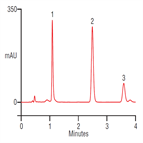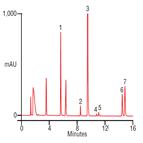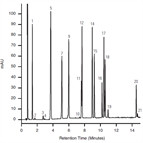Find methods for your needs
Refine by Feature
Displaying 1-5 of 20 results for Tag: Preservative
Rapid analysis of hydrocortisone in topical cream
Instrument Type: HPLCThe Thermo Scientific UltiMate 3000 HPLC system is applied for the analysis of hydrocortisone in topical cream. The separation is performed using a Thermo Scientific Acclaim 120 C18 column, with UV detection at 245 nm.
Improved separation of vitamins and other ingredients in an energy drink using a Thermo Scientific PolarAdvantage HPLC column
Instrument Type: HPLCThe Thermo Scientific HPLC system is applied for the analysis of vitamins and other ingredients in an energy drink. The separation is performed on a Thermo Scientific Acclaim PolarAdvantage (PA) column, with UV detection.
Improved analysis of twenty one preservative compounds found in cosmetics using a Thermo Scientific Hypersil GOLD Phenyl column
Instrument Type: HPLCThe Thermo Scientific HPLC system is applied for the analysis of twenty one preservative compounds found in cosmetics. The separation is performed on a Thermo Scientific Hypersil GOLD Phenyl column, with UV detection at 254 and 214 nm.
Improved analysis of soft drink ingredients using a Thermo Scientific Acclaim Organic Acid (OA) column
Instrument Type: HPLCThe Thermo Scientific HPLC system is applied for the analysis of soft drink ingredients. The separation is performed using a Thermo Scientific Acclaim Organic Acid (OA) column, with UV detection at 210 nm. The Thermo Scientific Acclaim OA column is uniquely suited because of its aqueous compatibility for the separation of organic acids, and its hydrophobic selectivity for the separation of preservatives.
AN172: Determination of Azide in Aqueous Samples by Ion Chromatography with Suppressed Conductivity Detection
Instrument Type: ICThis application note describes how to routinely monitor for azide anion in aqueous samples including water, food products, bodily fluids, and biological buffers by using a Reagent-Free™ IC (RFIC™) system. The azide anion is determined in 35 min by using a 4-mm IonPac AS15 column, isocratic potassium hydroxide provided automatically by an eluent generator, and suppressed conductivity detection. The IC method allows direct injection of the sample, avoiding laborious derivatization or sample preparation, and is highly sensitive, providing a detection limit for azide in reagent water of 50 μg/L.





